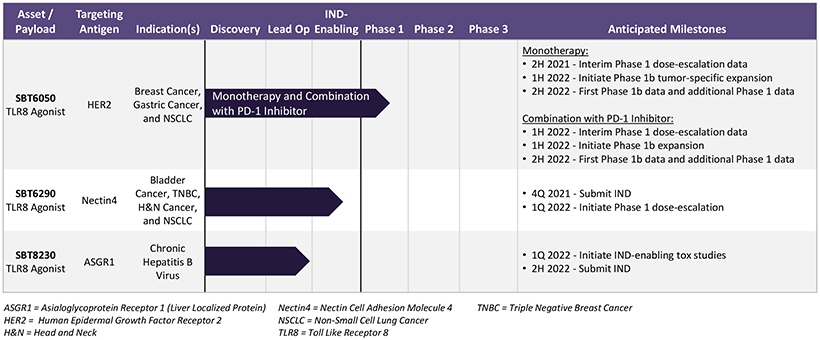continue to invest in innovation in the antibody-drug conjugate field, including but not limited to AbbVie, ADC Therapeutics, Astellas, BioAtla, Celldex, CytomX, Eli Lilly and Company, GlaxoSmithKline, Genmab, ImmunoGen, Millennium Pharmaceuticals, MorphoSys AG, Novartis, Pfizer, Sanofi, Seagen, and Sutro Biopharma.
Many of our competitors, either alone or with their collaboration partners, have significantly greater financial resources and expertise in research and development, preclinical testing, clinical trials, manufacturing and marketing than we do. Future collaborations and mergers and acquisitions may result in further resource concentration among a smaller number of competitors. Smaller or early-stage companies may also prove to be significant competitors, particularly through collaborative arrangements with large and established companies. These competitors will also compete with us in recruiting and retaining qualified scientific and management personnel and establishing clinical trial sites and subject registration for clinical trials, as well as in acquiring technologies complementary to, or that may be necessary for, our programs.
The key competitive factors affecting the success of all of our programs are likely to be efficacy, safety, and convenience. If we are not successful in developing, commercializing and achieving higher levels of reimbursement than our competitors, we will not be able to compete against them and our business would be materially harmed.
Our ability to use our net operating loss carryforwards and certain other tax attributes may be limited.*
We have incurred substantial losses during our history and do not expect to become profitable in the near future, and we may never achieve profitability. Unused U.S. federal net operating loss carryforwards (NOLs) for taxable years beginning before January 1, 2018, may be carried forward to offset future taxable income, if any, until such unused NOLs expire. Under legislation informally titled the Tax Cuts and Jobs Act (the Tax Act) enacted in 2017, as modified by legislation enacted on March 27, 2020, entitled the Coronavirus Aid, Relief, and Economic Security Act (the CARES Act), U.S. federal NOLs incurred in taxable years beginning after December 31, 2017, can be carried forward indefinitely, but the deductibility of such U.S. federal NOLs in taxable years beginning after December 31, 2020, is limited to 80% of taxable income. It is uncertain if and to what extent various states will conform to the Tax Act or to the CARES Act.
As of December 31, 2020, we had $89.7 million of U.S. federal NOLs. If not used, $18.2 million of the U.S. federal NOLs will begin to expire in 2036 and $71.5 million can be carried forward indefinitely under current law. As of December 31, 2020, we also had aggregate U.S. federal research and development (R&D) credits of approximately $1.5 million. Our NOL carryforwards and R&D credits are subject to review and possible adjustment by the U.S. and state tax authorities.
In addition, under Sections 382 and 383 of the Internal Revenue Code of 1986, as amended, and corresponding provisions of state law, if a corporation undergoes an “ownership change,” which is generally defined as a greater than 50 percentage point change (by value) in its equity ownership over a three-year period, the corporation’s ability to use its
pre-change
NOL carryforwards, R&D credits and certain other tax attributes to offset its post-change income or taxes may be limited. This could limit the amount of NOLs, R&D credit carryforwards or other applicable tax attributes that we can utilize annually to offset future taxable income or tax liabilities. Subsequent ownership changes and changes to the U.S. tax rules in respect of the utilization of NOLs, R&D credits and other applicable tax attributes carried forward may further affect the limitation in future years. In addition, at the state level, there may be periods during which the use of NOLs is suspended or otherwise limited, which could accelerate or permanently increase state taxes owed.
Our business operations and current and future relationships with investigators, health care professionals, consultants, third-party payors and customers are subject, directly or indirectly, to federal and state healthcare fraud and abuse laws, transparency laws and other healthcare laws and regulations. If we are unable to comply, or have not fully complied, with such laws, we could face substantial penalties.
Although we do not currently have any products on the market, our operations may be, directly or indirectly through our prescribers, customers and third-party payors, subject to various U.S. federal and state healthcare laws and regulations, including, without limitation, the U.S. federal Anti-Kickback Statute, the U.S. federal civil and criminal false claims laws and the Physician Payments Sunshine Act and regulations. Healthcare providers and others play a primary role in the recommendation and prescription of any products for which we obtain marketing
